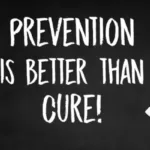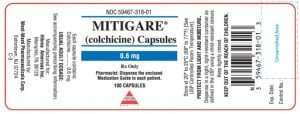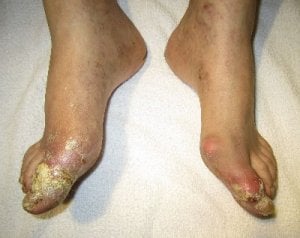Allopurinol rash has once again become a hot topic amongst worried gout patients. So if you are worried about Allopurinol Hypersensitivity Syndrome (ASH) read on.
The 2012 gout guidelines include recommendations for pre-screening certain groups.
This is not a new risk for allopurinol side effects. It is a helpful guideline to try to provide better treatment choices in high-risk groups.
Allopurinol Rash Purpose
I wrote about allopurinol rash to help Gout Patients discuss potential uric acid treatment with their doctor during the pre-treatment phase of their plan. So this supports the Purpose of GoutPal.com by encouraging the patient-physician relationship for effective gout management.
But what if you do not identify yourself as a gout patient seeking medical uric acid treatment? I suggest you start at Questions for Gout Sufferers. Or skip to the end of this article where you can find allopurinol rash related information.
What Is Allopurinol Rash?
Allopurinol rash is simply any rash that has developed due to taking allopurinol. Though there is a serious form, presence of a rash is not always dangerous. If a rash occurs whilst you are taking allopurinol, you must see your doctor immediately. Do not waste time discussing symptoms in the gout forum. The forum is a place to discuss general aspects of gout, it is not suitable for specific advice on your current medical condition.
Your doctor will probably order blood tests. Also, they may advise that you discontinue allopurinol until the test results are available.
The serious form of allopurinol rash is known as allopurinol hypersensitivity syndrome. Though rare, it is serious. It is the reason why doctors start allopurinol dosage at 100 mg per day, then increase if liver and kidney function tests reveal no abnormalities.
Avoiding Allopurinol Rash
For most people, you do not have to do anything to avoid the rash – simply start allopurinol at 100 mg, and if all clear, increase the dose until your uric acid level is safe at 5 mg/dL or below. For gout patients with Chronic Kidney Disease (CKD) at stage 4 or worse, allopurinol should be started at 50 mg per day.
Recently, there has been lots of research in China, Korea, & Taiwan about allopurinol hypersensitivity syndrome. This is incorporated into the latest rheumatologist’s gout guidelines as:
Prior to initiation of allopurinol, rapid polymerase chain reaction-based HLA-B*5801 screening should be considered as a risk management component in subpopulations where both the HLA-B*5801 allele frequency is elevated and the HLA-B*5801-positive subjects have a very high hazard ratio (“high risk”) for severe allopurinol hypersensitivity reaction (e.g., Koreans with stage 3 or worse CKD and all those of Han Chinese and Thai descent).
The Task Force Panel who compiled this recommendation concluded that this particular test was not justified in other ethnic groups. Note that, as clarified in a recent interview with a lead rheumatologist who was involved in the guidelines, this is not a complete risk assessment. The guidelines are based on the data available from published gout studies. Data was only available for the ethnic groups mentioned in the guidelines. This does not mean that other groups are risk-free.
Therefore, the advice to start at 100 mg per day allopurinol, and increase dosage if no symptoms show, will avoid any risks of serious effects from allopurinol hypersensitivity.

Dealing With Allopurinol Rash
It used to be the case that gout patients who presented this serious form of allopurinol rash could not get gout treatment. There are some reports of desensitization programs, but these are not common. These days, gout patients have further choices of febuxostat (marketed as Uloric or Adenuric) and pegloticase (marketed as Krystexxa).
Rheumatologists are keen to point out that they have new tools, and a new attitude to achieve gout-free patients by treating to target. This may take time to filter down to rank and file rheumatologists and general medical practitioners.
Stay safe before you start new gout treatment and ask your doctor if they are familiar with the 2012 American Gout Guidelines (British and European guidelines are also available). Allopurinol rash might never go away, but with the right approach to gout treatment, it should become even rarer than it has been.
For more information about avoiding problems with allopurinol, please see my Minimize Allopurinol Side Effects guidelines
Leave Allopurinol Rash to browse the Allopurinol Side Effects index. Or continue with your GoutPal Plan for Gout Patients.
Allopurinol Rash Related Topics
Please remember: to find more related pages that are relevant to you, use the search box near the top of every page.
Common Terms: allopurinol, Most Helpful Gout Pages, rash
Other posts that include these terms:
- High Alkaline Foods for Gout Diet Menu
- Gout Foods Table for Vegetables
- Gout Food List for GoutPal Foodies
- Foods High in Uric Acid Chart
- Purine Rich Foods
- Does Alcohol Affect Gout?
- Colchicine For Gout
Please give your feedback
Did this page help you? If yes, please consider a small donation. Your donations help keep GoutPal's gout support services free for everyone.
If not, please tell me how I can improve it to help you more.
- YouTube
- The gout forums.










